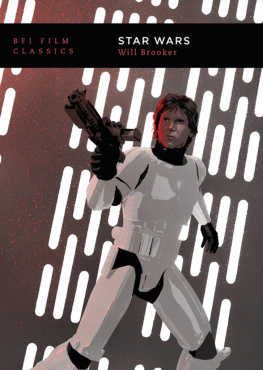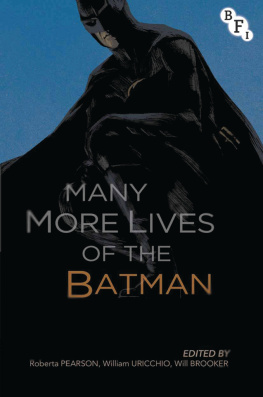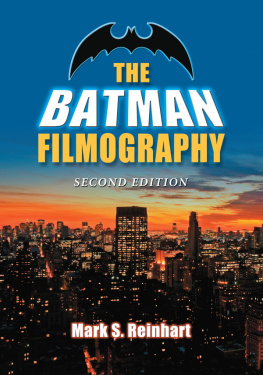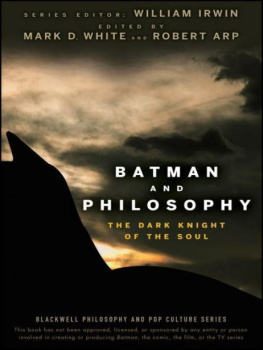Batman Unmasked
ALSO AVAILABLE:
Gray:
Song and Dance Man, 3rd Edition
Harper:
Women in British Cinema
Jones and Jolliffe:
The Guerilla Film Makers Handbook, 2nd Edition
Macnab:
Searching for Stars
Rayner:
The Films of Peter Weir
Vincendeau:
Stars and Stardom in French Cinema
BATMAN UNMASKED
Analyzing a Cultural Icon
Will Brooker

Bloomsbury Academic
An imprint of Bloomsbury Publishing Inc
1385 Broadway | 50 Bedford Square |
New York | London |
NY 10018 | WC1B 3DP |
USA | UK |
www.bloomsbury.com
Bloomsbury is a registered trade mark of Bloomsbury Publishing Plc
First published in 2001 by the Continuum International Publishing Group Inc
Will Brooker 2000
All rights reserved. No part of this publication may be reproduced or transmitted
in any form or by any means, electronic or mechanical, including photocopying,
recording, or any information storage or retrieval system, without prior
permission in writing from the publishers.
No responsibility for loss caused to any individual or organization acting on or
refraining from action as a result of the material in this publication
can be accepted by Bloomsbury or the author.
Library of Congress Cataloging-in-Publication Data
A catalog record for this book is available from the Library of Congress.
eISBN-13: 978-1-6235-6019-5
Contents
Acknowledgements
Thanks to:
Denny ONeil and Alan Asherman at DC Comics, who generously shared their time, their archives and their memories.
Roberta Pearson for her support, her encouragement and her example.
Deborah Jermyn for buying me Robertas The Many Lives of the Batman second-hand in 1995.
John Hartley for his inspiring background presence and for always finding the money.
David Barker at Continuum for his unflagging faith and enthusiasm.
Fiona Graham for the index.
Justine Davis, who loyally assisted with the New York research.
Liz Brooker, who proofread my first Batman story in 1978.
Pete Brooker, who brought home The Dark Knight Returns in 1985.
Joe Brooker, boy wonder.
Will Brooker
Cardiff New York London
May 1999
Twinkle, Twinkle Little Bat
How I Wonder what Youre at
(Lewis Carroll, Alices Adventures in Wonderland)
Gloria Hunniford: Do you regard yourself as a cultural icon Adam?
Adam West: it doesnt matter.
(Adam West with Will Brooker and Gloria Hunniford, Open House with Gloria Hunniford, Channel 5, 14 April 2000)
Introduction
1978
What are now called Departments of English will be renamed departments of Cultural Studies where Batman comics, Mormon theme parks, television, movies and rock will replace Chaucer, Shakespeare, Milton, Wordsworth and Wallace Stevens (Harold Bloom, The Western Canon, London: Macmillan (1994), p. 519)
1. Hunt the Dark Knight
I have kept a diary consistently since I was very young since the age of seven, but more of that below and on 29 July 1992 I pasted in two photographs, one from the Guardian and one from the Greenwich and Woolwich Mercury. The first is a snatched image of a man and a woman running, hand in hand. The woman clutches a bag and seems to be panting; the man is grim, focused, wearing shades and a jacket. Beneath his jacket, half-concealed, is a Batman t-shirt. The caption explains: On the run: a couple sprint across a Sarajevo intersection where snipers often attack civilians.
The second photograph is a posed portrait. A boy of about five years old sits on a hospital bed, slightly cross-eyed and bewildered, bravely giving a thumbs-up at the camera. To his left is a figure in a Ninja Turtle outfit, bending over the bed: to his right is a teenage boy dressed in an amateurish Batman costume. Welcome! reads the caption. Batman and Ninja Turtle drop in for a slice of the action. Above these two photos I added the legend Hunt the Dark Knight, a quotation from

With retrospect I believe that was the point at which the writing of this book began; with that spontaneous impulse to record and preserve two texts which in turn record and preserve the signifier of the Batman in such intriguing circumstances. I wanted to know how the Bat-symbol had infiltrated those places, those moments, and what it meant to the man sprinting across a sniper junction in Sarajevo, to the older boy dressing up for his terminally ill brother in a childrens ward of Greenwich Hospital. These images, linked across time and circumstance by the single icon of a stylised black bat in a yellow circle, retain their fascination and crystallise my wider project.
This book is an investigation, a detection, a forensic examination of the disparate texts which have borne the signifier Batman over sixty years, in an attempt to reconstruct their context and hence recover the meanings carried by this cultural icon at key moments in his history. The scope of my research, from the characters first published appearance in May 1939 to the comic books published around his anniversary in May 1999, is broad enough even with a focus primarily on American cultural history alone to draw in a range of texts from World War Two propaganda posters through 1960s Pop Art to the online fangroups of the Internet. My questions, though, remain consistent regardless of period. What does the Batman signify in this cultural moment? What wider context surrounds this particular inflection? What different interpretations govern this meaning, and within which matrix of imposed, dominant, delimiting and counter-definition is it situated?
The issues raised by these questions lead me to examine the fundamental relations between cultural power and textual interpretation, but they are always grounded in the concrete: and all these questions, all these issues are loaded in these two photographs linked , its spin-offs reaching even Sarajevo, and the boy in the cheap costume, either lovingly home-made or rented from a fancy-dress agency somewhere in Woolwich. From corporate merchandise to localised creativity, the adult consumer to the primary-school fan, the warzone crossfire to the leukaemia bed Batman got there, somehow, and the questions raised by these death-marked images alone are enough, I feel, to justify this books existence.
2. Confession: I Love Batman
It has become common even fashionable for academic writers to declare their own cultural positionality in relation to the texts they are addressing. In some cases for instance, Andy Medhursts foregrounding of his age, gayness and lack of any fannish investment in the character at the start of his essay Batman, Deviance and Camp
Nevertheless, I am convinced that my own exceptional position in relation to my subject must be declared; however I struggle for objectivity, I am so far inside the Batman myth as to be its subject myself, and an examination of readings and interpretations is inevitably affected by my own preferences, even as I try to regard the fan-self from the separate identity of the outsider and objective researcher. In this sense I feel the cultural experience which has woven me into Batman fandom is a benefit to my work, offering me a subject to examine intimately; but this requires a degree of honesty and self-interrogation both here and throughout.
Next page








